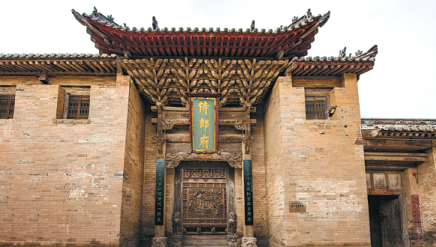Village offers historical lessons in good living

The residence of Qing Dynasty official Tian Fengji is among the most imposing structures in Lianghu. [Photo by Zhang Xiaomin for China Daily]
Shao Linlin, an official of Lianghu in the Shanxi county of Gaoping, is happy to see that the village he is so familiar with is becoming known to tourists from across the country.
The village's history, which he said is more than a millennium long, has become an asset for locals to increase their income and is improving livelihoods.
Shao said the village's rise to fame should be attributed to rural cultural heritage researchers like Chen Zhihua.
The village, at the foot of Taihang Mountains, first attracted the attention of Chen more than a decade ago. He is a professor at Beijing-based Tsinghua University and a researcher of rural culture and architecture.
During his research tours of Lianghu, Chen said the village is a living fossil of ancient China. As such, it is representative of well-preserved ancient villages that were built in the Ming (1368-1644) and Qing (1644-1911) dynasties.
While showing his gratitude to experts like Chen, Shao said he has more to say about the history of his home village.
"Local legends said the village has a history of more than two millennia," Shao said. "But I can tell for sure the village should be more than 1,000 years, based on records from our family history books."
He said the first settlers in the village were two families with the surnames of Guo and Tian, who came here during the Tang Dynasty (618-907).
"Because of this, the settlement was called Lianghu-or two households-village," Shao said, adding the community became larger as other families moved in.
Most of the village's buildings, including a residence of a high-ranking general, were built in the Ming and Qing dynasties, according to Shao.
"But the Yuxu Guan Taoist Temple was built at least 800 years ago," the official said.
Shao said he is proud of Lianghu's status as a renowned historical and cultural village in China.
"We have 17 Buddhist and Taoist temples built in various periods, as well as more than 30 well-preserved courtyards built in the Ming and Qing dynasties," Shao said.
He said the high level of craftsmanship that local builders used to build houses is one of the reasons why the ancient village has remained so intact to this date.
"Lianghu had been one of the most prosperous villages in the region. Locals accumulated their wealth through farming, commerce and handicrafts. The wealthy people highlighted the quality of their residences, hoping the properties could be passed down to as many generations as possible," Shao explained.
Among the ancient buildings, the most imposing is the former residence of Qing Dynasty official Tian Fengji.
Starting as a scholar, Tian later served as a civil official and a high-ranking general. After he retired, he returned to his birthplace of Lianghu to live a quiet life.
When studying the well-crafted ancient structures on-site and the lifestyles of ancient residents via local history books, Chen said Lianghu represented the best of rural China where people "enjoyed a decent life".
And that decent life continues to date, as locals live in prosperity and take pride of the culture created by their ancestors and themselves, Shao said.
Wang Pei contributed to this story.



